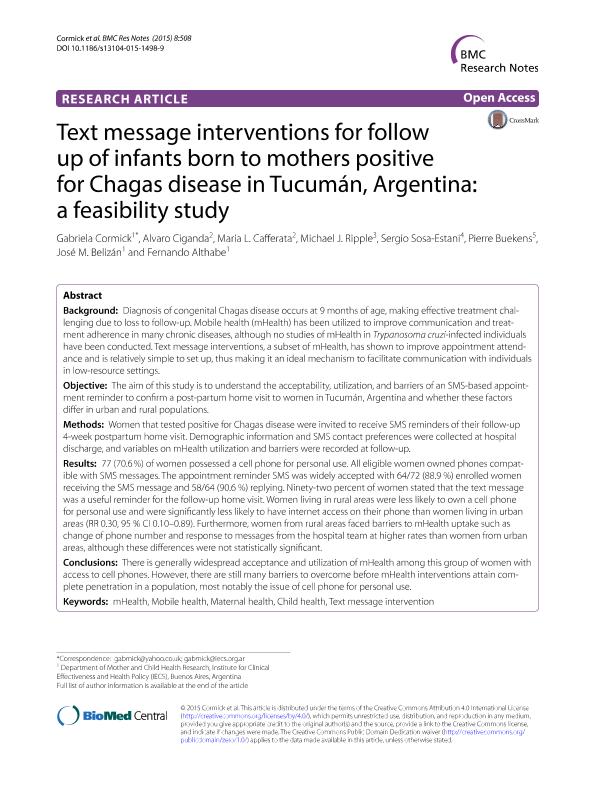Mostrar el registro sencillo del ítem
dc.contributor.author
Cormick, Gabriela

dc.contributor.author
Ciganda, Alvaro
dc.contributor.author
Cafferata, Maria Regina

dc.contributor.author
Ripple, Michael J.
dc.contributor.author
Sosa-Estani, Sergio Alejandro

dc.contributor.author
Buekens, Pierre

dc.contributor.author
Belizan, Jose

dc.contributor.author
Althabe, Fernando

dc.date.available
2018-10-01T19:04:50Z
dc.date.issued
2015-09
dc.identifier.citation
Cormick, Gabriela; Ciganda, Alvaro; Cafferata, Maria Regina; Ripple, Michael J.; Sosa-Estani, Sergio Alejandro; et al.; Text message interventions for follow up of infants born to mothers positive for Chagas disease in Tucumán, Argentina: A feasibility study Infectious Diseases; BioMed Central Ltd.; BMC Research Notes; 8; 1; 9-2015; 1-8
dc.identifier.issn
1756-0500
dc.identifier.uri
http://hdl.handle.net/11336/61416
dc.description.abstract
Background: Diagnosis of congenital Chagas disease occurs at 9 months of age, making effective treatment challenging due to loss to follow-up. Mobile health (mHealth) has been utilized to improve communication and treatment adherence in many chronic diseases, although no studies of mHealth in Trypanosoma cruzi-infected individuals have been conducted. Text message interventions, a subset of mHealth, has shown to improve appointment attendance and is relatively simple to set up, thus making it an ideal mechanism to facilitate communication with individuals in low-resource settings. Objective: The aim of this study is to understand the acceptability, utilization, and barriers of an SMS-based appointment reminder to confirm a post-partum home visit to women in Tucumán, Argentina and whether these factors differ in urban and rural populations. Methods: Women that tested positive for Chagas disease were invited to receive SMS reminders of their follow-up 4-week postpartum home visit. Demographic information and SMS contact preferences were collected at hospital discharge, and variables on mHealth utilization and barriers were recorded at follow-up. Results: 77 (70.6∈%) of women possessed a cell phone for personal use. All eligible women owned phones compatible with SMS messages. The appointment reminder SMS was widely accepted with 64/72 (88.9 %) enrolled women receiving the SMS message and 58/64 (90.6 %) replying. Ninety-two percent of women stated that the text message was a useful reminder for the follow-up home visit. Women living in rural areas were less likely to own a cell phone for personal use and were significantly less likely to have internet access on their phone than women living in urban areas (RR 0.30, 95 % CI 0.10-0.89). Furthermore, women from rural areas faced barriers to mHealth uptake such as change of phone number and response to messages from the hospital team at higher rates than women from urban areas, although these differences were not statistically significant. Conclusions: There is generally widespread acceptance and utilization of mHealth among this group of women with access to cell phones. However, there are still many barriers to overcome before mHealth interventions attain complete penetration in a population, most notably the issue of cell phone for personal use.
dc.format
application/pdf
dc.language.iso
eng
dc.publisher
BioMed Central Ltd.
dc.rights
info:eu-repo/semantics/openAccess
dc.rights.uri
https://creativecommons.org/licenses/by-nc-sa/2.5/ar/
dc.subject
Child Health
dc.subject
Maternal Health
dc.subject
Mhealth
dc.subject
Mobile Health
dc.subject
Text Message Intervention
dc.subject.classification
Salud Ocupacional

dc.subject.classification
Ciencias de la Salud

dc.subject.classification
CIENCIAS MÉDICAS Y DE LA SALUD

dc.title
Text message interventions for follow up of infants born to mothers positive for Chagas disease in Tucumán, Argentina: A feasibility study Infectious Diseases
dc.type
info:eu-repo/semantics/article
dc.type
info:ar-repo/semantics/artículo
dc.type
info:eu-repo/semantics/publishedVersion
dc.date.updated
2018-09-10T16:02:02Z
dc.journal.volume
8
dc.journal.number
1
dc.journal.pagination
1-8
dc.journal.pais
Reino Unido

dc.journal.ciudad
Londres
dc.description.fil
Fil: Cormick, Gabriela. Consejo Nacional de Investigaciones Científicas y Técnicas; Argentina. Instituto de Efectividad Clínica y Sanitaria; Argentina
dc.description.fil
Fil: Ciganda, Alvaro. Unidad de Investigación Clínica y Epidemiológica Montevideo; Uruguay
dc.description.fil
Fil: Cafferata, Maria Regina. Unidad de Investigación Clínica y Epidemiológica Montevideo; Uruguay
dc.description.fil
Fil: Ripple, Michael J.. University of North Carolina; Estados Unidos
dc.description.fil
Fil: Sosa-Estani, Sergio Alejandro. Consejo Nacional de Investigaciones Científicas y Técnicas; Argentina. Dirección Nacional de Instituto de Investigación. Administración Nacional de Laboratorio e Instituto de Salud “Dr. C. G. Malbrán”. Instituto Nacional de Parasitología "Dr. Mario Fatala Chaben”; Argentina
dc.description.fil
Fil: Buekens, Pierre. Tulane University; Estados Unidos
dc.description.fil
Fil: Belizan, Jose. Consejo Nacional de Investigaciones Científicas y Técnicas; Argentina. Instituto de Efectividad Clínica y Sanitaria; Argentina
dc.description.fil
Fil: Althabe, Fernando. Consejo Nacional de Investigaciones Científicas y Técnicas; Argentina. Instituto de Efectividad Clínica y Sanitaria; Argentina
dc.journal.title
BMC Research Notes
dc.relation.alternativeid
info:eu-repo/semantics/altIdentifier/doi/https://dx.doi.org/10.1186/s13104-015-1498-9
dc.relation.alternativeid
info:eu-repo/semantics/altIdentifier/url/https://bmcresnotes.biomedcentral.com/articles/10.1186/s13104-015-1498-9
Archivos asociados
